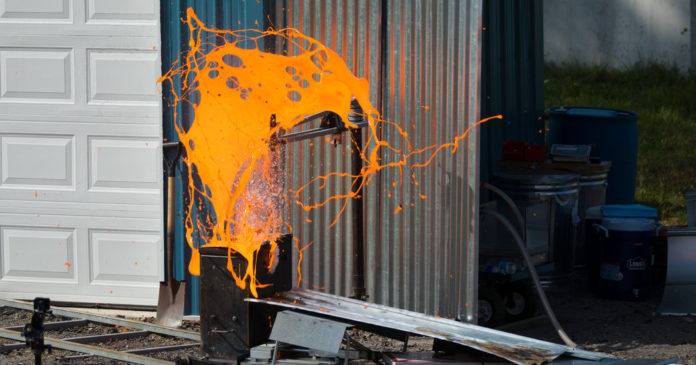When lava meets water, the results are often explosive.
Last year, lava from Hawaii’s Kilauea volcano flowed into the ocean, creating bombs of molten rock that were flung into the sky and then smashed into a nearby tourist boat, injuring 23 people.
In 2010, a glacier-covered volcano in Iceland called Eyjafjallajökull erupted and spewed a plume of ash 30,000 feet into the air, causing hundreds of flights in Europe to be grounded.
Scientists want to better understand these violent reactions to help prepare communities near volcanoes and bodies of water or groundwater. But doing so at active sites can be impractical. Instead, a team of researchers recently brewed their own backyard lava.
“We are not just crazy people mixing and seeing what happens,” said Ingo Sonder, a volcanologist at the University at Buffalo. “We are scientists and we want to quantify, and we do have an idea of what we are doing here.”
First, Dr. Sonder and his colleagues got black chunks of ancient solidified lava, called basalt, from a quarry in Texas. They poured about 120 pounds of basalt into a crucible inside a furnace. Over four hours, with a few occasional stirs, the furnace heated the rocks to about 2,400 degrees Fahrenheit, until the basalt became a bubbling molten mix.
[Like the Science Times page on Facebook. | Sign up for the Science Times newsletter.]
Donning silver thermal suits to protect against the intense heat and radiation, the researchers then poured 10 gallons of glowing goop into a series of insulated steel boxes. The containers varied in size: Some were long and flat, while others were tall and narrow, like a chimney, in order to replicate the types of magma columns found in nature.
The walls of the steel containers had injectors designed to spray pressurized water into the piping hot lava. After each contraption was moved a safe distance from the shed that housed the furnace, the scientists initiated a countdown on their computers.
Often, the instant the water hit the lava, it exploded, sending a blazing blob about six feet into the air, and a few lava bombs as high as 15 feet. But other times nothing happened, so the researchers used a remotely controlled sledgehammer to knock the container and trigger the blast.
The team used high-speed cameras to catch video of the explosions and published the first of their results, still preliminary, last month in the journal JGR-Solid Earth. They plan to continue brewing lava, carrying out the experiment with differently shaped containers and varying amounts of water.
“If we have a better idea of what conditions cause these violent lava-water explosions,” said Greg Valentine, a volcanologist at the University at Buffalo and an author on the paper, “then we can do a better job of kind of warning people and mitigating the hazard.”
Source : Nytimes













